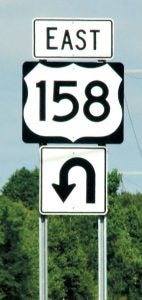Redesign approved
Published 11:03 am Tuesday, June 5, 2018
WINTON – The North Carolina Department of Transportation will move forward with plans to transform the Murfreesboro Bypass (US 158 / US 258) into a Superstreet design and raise the speed limit from 55 to 60 mph.
That upgrade, which will include the removal of the stoplights at the NC 11 and Spring Avenue intersections, was requested earlier this year by the Hertford County Board of Commissioners.
Winn Bridgers, NCDOT Division One Maintenance Engineer, attended yesterday’s (Monday) regularly

Directional turn signs such as this along a portion of US 158 near Winton will soon greet motorists on the Murfreesboro Bypass. | Staff photo by Cal Bryant
scheduled meeting of the commissioners where he updated the board of the plans. He referenced a March 5 meeting of the commissioners where those plans were discussed with him and other NCDOT Division One officials.
“We went and pursued the project (from that point) and recently secured funding for the project,” Bridgers said. “However, from checking the minutes from the March 5 meeting, there was an acknowledgment of the project, but it wasn’t a formal resolution (from the board). I contacted the County Manager (Loria Williams) and ask if we could get a resolution approved so we could proceed with the removal of the stoplights on the Murfreesboro Bypass and converting it to the Superstreet concept.”
Bridgers explained the Superstreet design is what currently exists east of the Murfreesboro Bypass towards Winton. The same design is used on US 13 North / US 158 East) from Winton to Tar Heel in Gates County. Roads joining the “superstreet” can only turn right onto it. To turn left and travel in the other direction, drivers must first turn right and then make a U-turn in a designated area.
Bridgers said that type of design simplifies the number of choices for drivers, thusly minimizing the conflict points at an intersection.
According to the NCDOT’s presentation on superstreets, a typical intersection has 32 potential conflict points, while a superstreet only has 14.
“Reducing the conflict points helps reduce the number of serious wrecks,” Bridgers noted. “This design prevents the t-bone types of accidents, the ones that are the most severe.
“Yes, it causes a change that require people getting use to it, but once they do it becomes a habit and we’ll see a drastic reduction in the number of accident rates as there will be no more left turns and no more crossing directly through an intersection with traffic coming at a motorist from the opposite direction,” Bridgers added in his explanation of the safety advantages of the Superstreet design.
Commissioner John Horton pointed out there are three traffic lights on the Murfreesboro Bypass.
“We’re not going to take away the one at the intersection of 158 and 258 which is actually in Northampton County,” Bridgers said. “We’re going to remove the traffic lights at the Spring Avenue and NC 11 intersections as they are in Hertford County. Some of the other (road) crossings will be taken out and combined into the Superstreet design.”
As far as the traffic signal at the intersection of US 158 and US 258 located at the western end of the bypass, Bridgers said that one is, “tied into a future phase of 158, plus Northampton County hasn’t requested removing that light.”
Bridgers added that once the Superstreet design is in place on the Murfreesboro Bypass, the speed limit will be raised to 60 mph for all of US 158 in Hertford County.
With their approval of removing the stoplights and utilizing the Superstreet concept, the Hertford County Board of Commissioners supports the project and formally requests NCDOT to move forward to implement this design along the Murfreesboro Bypass.



